Updated May 8, 2023
Are you wondering how you can safely prepare food while pregnant?
Safe food handling during pregnancy is critical to your health and the health of your unborn baby.
A staggering 50 million people get sick from food-borne illnesses in the US every year.
So let’s talk about how you can properly prepare the foods you love and stay safe while pregnant.
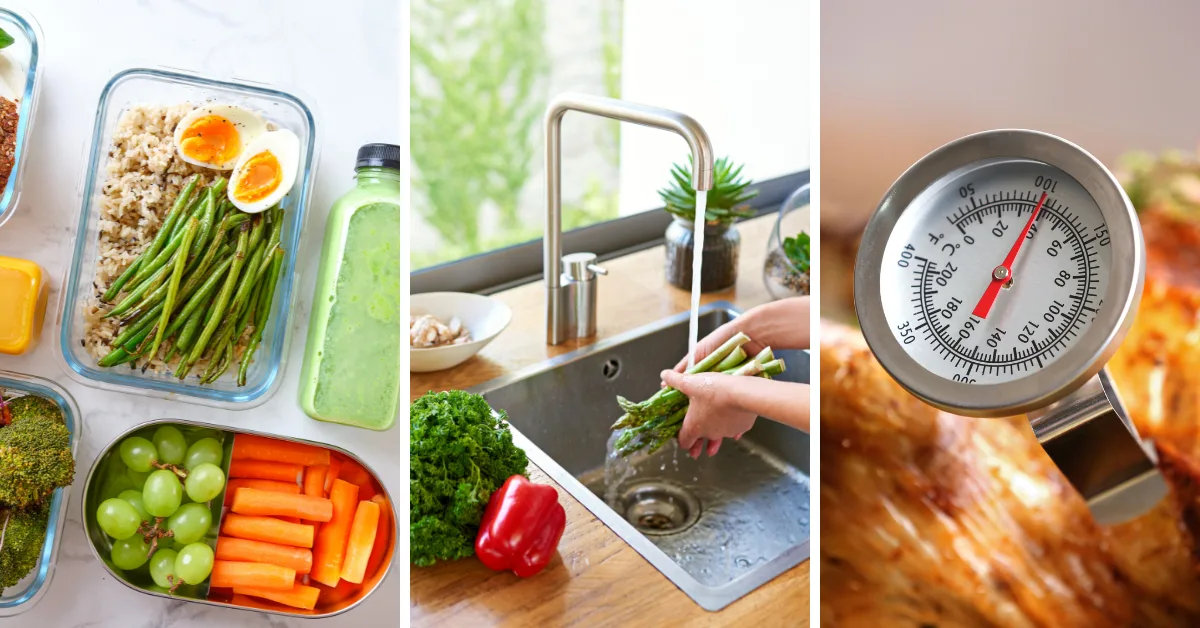
Tips for safe food handling during pregnancy
We asked our OB/GYN, Dr. Doug Penta for safe food handling and preparation tips for pregnancy.
And he said when you’re pregnant, it’s important to take extra precautions when it comes to handling and preparing food.
Follow these tips to minimize the risk of foodborne illness:
- Wash your hands thoroughly with soap and water before and after handling food.
- Clean all surfaces and utensils that come into contact with food, including cutting boards, countertops, and knives.
- Separate raw meats, poultry, and seafood from other foods to prevent cross-contamination.
- Cook all meats, poultry, and seafood to the appropriate temperature to kill any harmful bacteria. Use a meat thermometer to ensure that the internal temperature has reached the safe minimum.
- Refrigerate perishable foods promptly and keep them at a safe temperature of 40°F or below. Don’t leave food out at room temperature for more than two hours.
According to the Centers for Disease Control and Prevention (CDC), an estimated 48 million people get sick, 128,000 are hospitalized, and 3,000 die from foodborne diseases each year in the United States
So how can you be sure you are doing all you can to prevent food-borne illness during pregnancy?
First and foremost, it is important to practice good hand hygiene.
Wash your hands thoroughly with soap and warm water before and after handling food, as well as after using the bathroom or changing diapers.
This is the most important thing you can do to prevent infections and illnesses during pregnancy.
Use separate cutting boards and utensils for raw meat, poultry, and seafood, and wash them thoroughly with hot, soapy water after each use.
When it comes to cooking, make sure that all meat, poultry, and seafood are cooked to the appropriate temperature to kill any harmful bacteria.
Use a food thermometer to ensure that the internal temperature of these foods reaches the recommended temperature.
Avoid eating raw or undercooked eggs, as they can be contaminated with Salmonella.
Be sure to wash all fruits and vegetables thoroughly before eating or cooking.
According to the FDA, there are approximately 900 cases of Listeria infection in the US each year, and pregnant women are 20 times more likely to get Listeria infection than non-pregnant healthy adults.
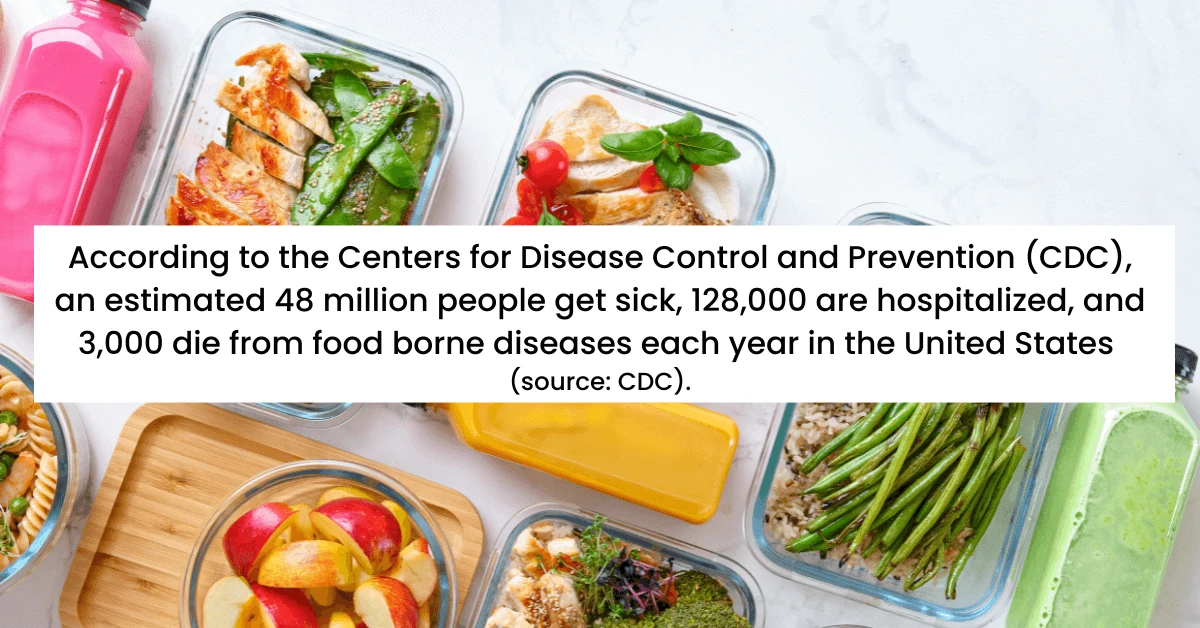
Why Safe Food Handling is Important for Pregnant Women
-
Food-borne Illness and Pregnancy
When you’re pregnant, your immune system is weakened, making you more susceptible to food-borne illnesses.
These illnesses can cause serious health problems for both you and your unborn baby.
The Federal government estimates that there are about 48 million cases of foodborne illness annually in the US.
Some food-borne illnesses, such as listeria and toxoplasmosis, can even lead to miscarriage, stillbirth, or premature delivery.
To avoid these risks, it’s important to practice safe food handling and preparation techniques.
This means taking extra care to avoid cross-contamination, properly storing and cooking food, and avoiding certain high-risk foods.
Symptoms of food poisoning often include diarrhea, vomiting, upset stomach, or nausea.
Call your healthcare provider if you have severe symptoms such as diarrhea and a fever higher than 102°F, diarrhea for more than three days that is not improving, or bloody diarrhea (CDC).
-
Proper Food Handling Techniques
To minimize the risk of foodborne illnesses during pregnancy, it’s important to follow proper food handling techniques.
This includes washing your hands frequently, especially before and after handling food, and using separate cutting boards and utensils for raw and cooked foods.
When storing food, make sure to refrigerate perishable items promptly, and don’t leave food out at room temperature for more than two hours.
When cooking, use a food thermometer to ensure that meat, poultry, and fish are cooked to a safe temperature.
-
High-Risk Foods to Avoid
Certain foods are more likely to be contaminated with harmful bacteria or parasites, making them high-risk foods for pregnant women.
- Foods that are not pasteurized – certain types of cheese like soft cheeses, Brie, Blue Cheese, etc. May contain harmful bacteria such as listeria
- Certain types of fish– shark, swordfish, anything high in mercury.
- Raw eggs – including egg nog, hollandaise sauce, homemade mayonnaise, homemade eggnog, and runny eggs. May contain harmful bacteria such as salmonella and E. coli
- Undercooked meats – lunch meats. Deli meats. May contain harmful bacteria such as salmonella and E. coli.
- Hot foods that are not “hot”, avoid hot foods that have been sitting out without a warming source. Same for foods that should be eaten cold. If no ice or refrigeration source is keeping the food cold, take a pass.
- Caffeine – soda, chocolate, and energy drinks. (Limit your caffeine to less than 200 mg a day)
- Herbal Teas (There are so many ingredients in herbal teas so it is best to avoid them simply. Green tea is OK.)
- Alcohol – There is no known safe amount of alcohol that can be consumed during pregnancy.
- Raw Sprouts – Avoid raw sprouts such as alfalfa, mung bean, and radish.
It is also important to wash all fruits and vegetables thoroughly before eating them to remove any harmful bacteria.
Use separate cutting boards for meat and produce to avoid cross-contamination.
Cook all meat and poultry to the proper temperature to kill any harmful bacteria.
Use a food thermometer to ensure that meat is cooked to a safe temperature.
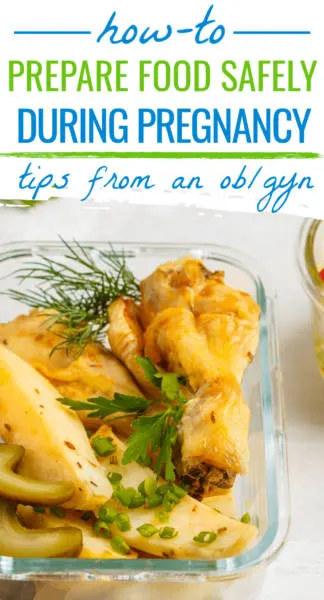
It’s also important to be aware of certain foods that can pose a higher risk of foodborne illness during pregnancy.
Avoid the following:
| Foods to Avoid During Pregnancy | Reasons to Avoid |
|---|---|
| Raw or undercooked meats, poultry, and seafood | May contain harmful bacteria such as salmonella, E. coli, and Listeria |
| Unpasteurized milk and dairy products | May contain harmful bacteria such as listeria |
| Soft cheeses made with unpasteurized milk | May contain harmful bacteria such as listeria |
| Raw or undercooked eggs | May contain harmful bacteria such as salmonella |
| Raw sprouts | May contain harmful bacteria such as E. coli and Salmonella |
How likely is it to get Listeria while pregnant?
According to the CDC, about 1,600 people get listeriosis each year, and about one in seven cases occurs in pregnant women (CDC).
The risk of getting listeria while pregnant is actually quite low, but it’s still essential to be cautious and informed.
Listeria is a type of bacteria that can cause foodborne illness.
Pregnant women are more susceptible to it because their immune systems are slightly weakened, making it harder to fight off infections.
If a pregnant woman contracts listeria, it can lead to severe complications for both mom and baby.
To minimize your risk, it’s essential to practice good food hygiene and avoid high-risk foods like raw or undercooked meats, seafood, and eggs, as well as unpasteurized dairy products and deli meats.
It’s also crucial to wash fruits and vegetables thoroughly before consuming them.
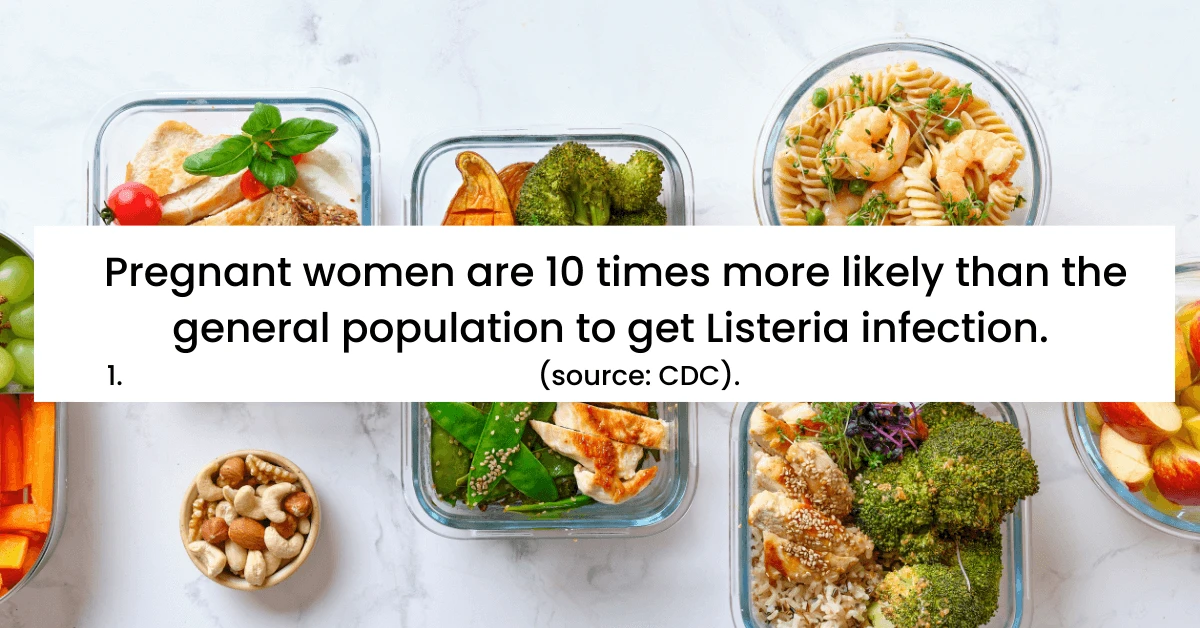
Cooking Meat and Poultry Safely
When cooking meat and poultry, it’s important to follow safe handling and cooking practices to reduce the risk of foodborne illness.
Here are some tips to help you cook meat and poultry safely:
- Use a separate cutting board for raw meat and poultry to avoid cross-contamination with other foods.
- Wash your hands thoroughly with soap and warm water before and after handling raw meat and poultry.
- Thaw frozen meat and poultry in the refrigerator, not on the counter, to prevent the growth of harmful bacteria.
- Cook meat and poultry to the appropriate internal temperature using a food thermometer.
- The recommended minimum internal temperatures are:
| Meat/Poultry | Minimum Internal Temperature |
|---|---|
| Beef, pork, veal, and lamb (steaks, roasts, and chops) | 145°F (63°C) with a 3-minute rest time |
| Ground meat (beef, pork, veal, and lamb) | 160°F (71°C) |
| Poultry (chicken, turkey, duck, and goose) | 165°F (74°C) |
Make sure to check the temperature of the thickest part of the meat or poultry with a food thermometer to ensure that it has reached the appropriate temperature.
Don’t rely on the color of the meat or poultry to determine if it’s done.
After cooking, keep hot foods at or above 140°F (60°C) and refrigerate leftovers within 2 hours to prevent the growth of harmful bacteria.
If you’re not sure if a food is safe to eat, it’s better to err on the side of caution and throw it out.
If you have any doubt about how long a food has been sitting out, throw it out.
I have had Salmonella.
You do not want to get a foodborne illness during pregnancy.
Handling Fruits and Vegetables
Fruits and vegetables are an essential part of this diet, but it is important to handle and prepare them safely to avoid the risk of foodborne illness.
According to the FDA, Produce has been implicated in 46 percent of foodborne illness outbreaks
The FDA recommends that you thoroughly rinse raw fruits and vegetables under running water before eating or preparing them, especially fruits that require peeling.
This helps to remove any dirt or bacteria that may be on the surface of the produce.
You do not need to use any soap or other cleaning agents, just water.
It is also important to keep your fruits and vegetables separate from raw foods that come from animals, such as meat, poultry, and seafood.
This helps to prevent cross-contamination and the spread of harmful bacteria.
When storing your fruits and vegetables, make sure to refrigerate them within 2 hours after you cut, peel, or cook them (or 1 hour if exposed to temperatures above 90°, like a hot car or picnic).
Chill them at 40°F or colder in a clean container.
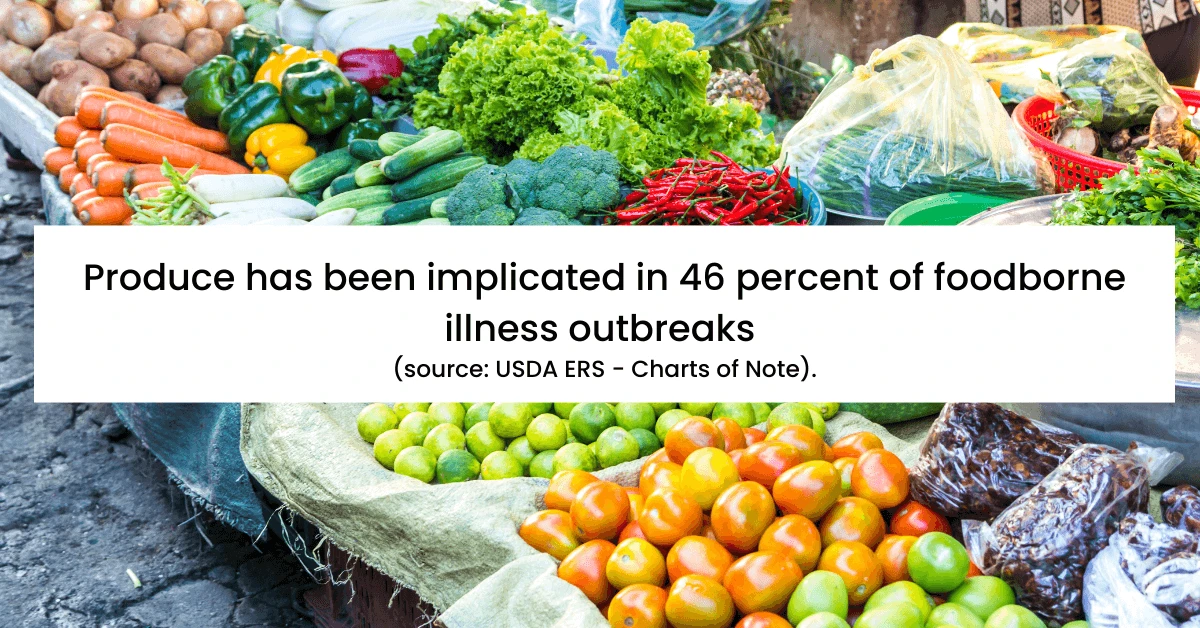
When it comes to cooking your fruits and vegetables, make sure to cook them to the appropriate temperature to kill any harmful bacteria.
Use a food thermometer to ensure that your food has reached a safe internal temperature.
For example, leafy greens should be cooked to 165°F, while root vegetables should be cooked to 135°F.
Here are some additional tips to help you handle and prepare your fruits and vegetables safely:
- Wash your hands thoroughly with soap and water before and after handling produce.
- Use separate cutting boards for produce and raw meat, poultry, and seafood.
- Use a vegetable brush to scrub produce that has firm skin, such as carrots and potatoes.
- Discard any produce that is bruised or damaged, as it may contain harmful bacteria.
- When buying pre-cut fruits and vegetables, make sure they are refrigerated or on ice.
Food Storage and Leftovers
Can I eat leftovers while pregnant?
Yes, you can eat leftovers while you are pregnant.
When you’re pregnant, it’s important to store and handle left food properly to reduce the risk of foodborne illness.
Here are some tips to keep in mind:
- Always refrigerate perishable foods within two hours of purchase or preparation to prevent bacteria from growing.
- Make sure your refrigerator is set to 40°F or below and your freezer is set to 0°F or below to keep food fresh.
- Store raw meat, poultry, and seafood in a separate container or on a separate shelf to prevent cross-contamination.
- Use airtight containers or wrap to store leftovers to prevent bacteria from growing.
- Label leftovers with the date so you know when to use them. Generally, leftovers should be used within four days. But if you want to err on the safe side eat all leftovers within 24 hours during pregnancy.
When reheating leftovers, make sure they reach an internal temperature of 165°F to kill any bacteria that may have grown.
It’s also important to properly handle and store leftover fruits and vegetables.
If you’re not going to leftover produce right away, store it in the refrigerator to keep it fresh.
Remember, following the four easy steps of Clean, Separate, Cook, and Chill can help prevent foodborne illness.
Properly washing fruits and vegetables, cooking meat to the appropriate temperature, and avoiding high-risk foods such as unpasteurized dairy products and raw seafood can help minimize risks.
Keeping perishable items refrigerated at the appropriate temperature, avoiding cross-contamination, and properly thawing frozen foods can help prevent the growth of harmful bacteria.


